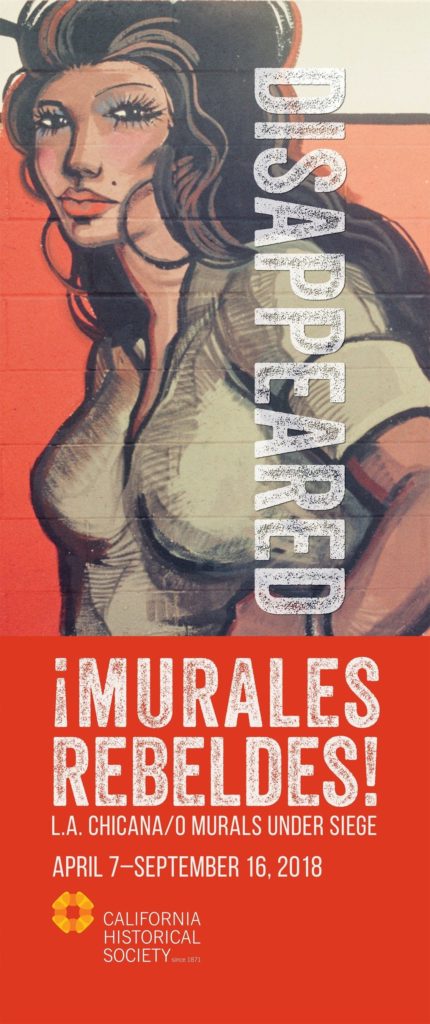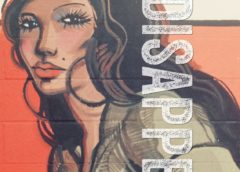
SAN FRANCISCO, March 26, 2018 — Murals became an essential form of artist response and public voice during the Chicana/o Movement of the 1960s and 1970s. They were a means of challenging the status quo and expressing both pride and frustration at a time when other channels of communication were limited for the Mexican American community. Because they threatened established authority, Chicana/o murals were often censored, neglected, whitewashed, or destroyed.
The California Historical Society presents its latest exhibition and companion publication, “¡Murales Rebeldes! L.A. Chicano/a Murals under Siege”, which provides an important historical backdrop to issues of social justice that sparked outrage in California more than a half century ago and continue today and provides insight to similar injustice that plague today’s socio-political environment.
“The historical context related to the issues of social justice that these murals so passionately portrayed decades ago are unfortunately painfully relevant today,” said California Historical Society Executive Director Anthea Hartig. “We are honored to bring this exhibition to San Francisco, particularly given the shared rich tradition of Chicano murals. We hope our visitors will gain insight on how these works of public art are relevant today and inspire hope and progress for future generations.”
Through photographs, sketches, documents, film footage, and even rescued fragments, ¡Murales Rebeldes! tells the stories of eight murals — by Barbara Carrasco, Yreina D. Cervántez and Alma López, Roberto Chavez, Ernesto de la Loza, Willie F. Herrón III, Sergio O’Cadiz Moctezuma, and East Los Streetscapers (David Botello, Wayne Alaniz Healy, and George Yepes) — that were censored, neglected, whitewashed, and even destroyed. They are a small fraction of the hundreds of murals under siege. Their fates represent a larger issue: Without protection and advocacy, Chicana/o murals — a cornerstone of California’s cultural and historical heritage — remain imperiled.
The exhibition examines these powerful murals that asserted Chicana/o history and identity in public spaces, challenged dominant norms, and provoked attempts to silence their poignant critiques. Examples include David Botello, Wayne Healy, and George Yepes of East Los Streetscapers, whose mural Filling up on Ancient Energies was destroyed without providing any notification to the artists. The lawsuit they won in favor of their mural has left a legal legacy for the protection of murals in California today. Barbara Carrasco’s L.A. History: A Mexican Perspective was censored for depictions of Los Angeles’s “controversial” histories even before it was painted. Today, after its 40 panels languished in storage for decades, Carrasco’s mural is being featured in Los Angeles, in large part from the work initiated by this exhibition. Murals by Ernesto de la Loza, Roberto Chavez, Yreina Cervántez and Alma López, Willie Herrón, and Sergio O’Cadiz, suffered similar outcomes—each a story of threats and loss that reveals the artists’ resistance and resilience.
“Murals have played an important role in documenting the history, politics, fears, as well as the dreams and aspirations of historically marginalized populations,” said Carrasco. “I am honored to be part of this important exhibition and to share my personal story along with the stories of my fellow muralists, particularly during today’s turbulent times.”
¡Murales Rebeldes! was organized by the California Historical Society and LA Plaza de Cultura y Artes and made possible through lead grants from the Getty Foundation. Major funding is provided by the Annenberg Foundation and the Ratkovich Company. The exhibition originated as part of the Getty initiative Pacific Standard Time: LA/LA. The presenting sponsor was Bank of America. The exhibition, which just completed a six-month showing at LA Plaza de Cultura y Artes in Los Angeles, is curated by California Historical Society Director of Exhibitions Jessica Hough, in collaboration with LA Plaza Senior Curator Erin M. Curtis and Ohio State University associate professor Guisela Latorre.
“Telling these stories sheds light on censorship, the arts and how society as a whole responds to issues of free speech and social injustice,” said Hough. “Through the showcasing of these works, the educational programming and lectures, we hope to provide historical context that is relevant in today’s socio-political landscape.”
¡Murales Rebeldes! will be on view at the galleries of the California Historical Society, located at 678 Mission Street in San Francisco, from April 7 to September 16, 2018. The companion publication can be purchased online through the California Historical Society website or at its gallery bookstore and gift shop. Throughout the course of the exhibition, the California Historical Society will conduct a series of special programming, free public events and educational initiatives, including talks with artists, mural-making workshops, discussions about social justice issues, and visits with San Francisco artists and muralists. A free community celebration will take place on Saturday, April 14th from 11 am – 5 pm.
ABOUT CALIFORNIA HISTORICAL SOCIETY: The California Historical Society, founded in 1871, is a nonprofit organization with a mission to inspire and empower people to make California’s richly diverse past a meaningful part of their contemporary lives. Headquartered in San Francisco, with offices in Los Angeles offices located at LA Plaza de Cultura y Artes and outposts at the University of Southern California and the Autry National Center, the California Historical Society holds one of the state’s top historical collections, including some of the most cherished and valuable documents and images of California’s past, revealing California’s social, cultural, economic, and political history and development. Through high-quality exhibitions, public programs, publications, research, and preservation, the California Historical Society promotes public engagement throughout the state. Learn more at www.calhist.org.
SOURCE California Historical Society

Rod is a blogger, writer, filmmaker, photographer, daydreamer who likes to cook. Rod produces and directs the web series, CUPIC: Diary of an Investigator. He is also the editor, producer and administrator of STM Daily News, a part of the TNC Network.


